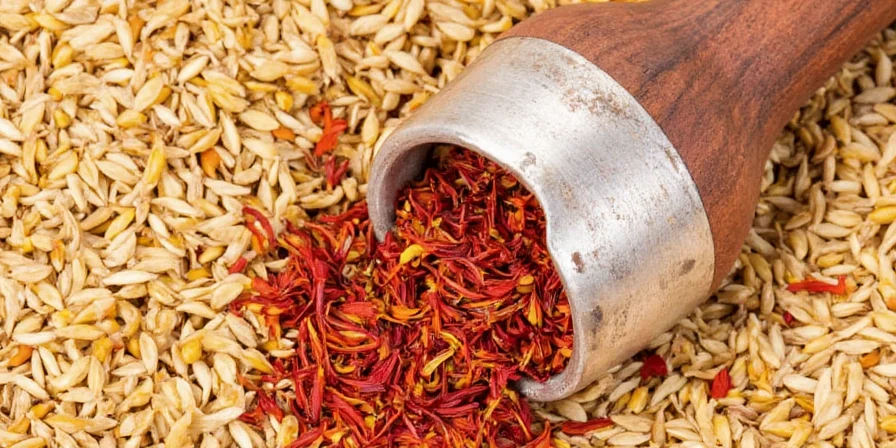Here's the quick answer you need: For perfect saffron basmati rice, use 1 cup aged basmati rice rinsed until water runs translucent, 1¼ cups spring water, and 15-20 saffron threads steeped in 2 tablespoons warm milk for 20 minutes. Cook on low heat for 15 minutes after water absorption, then steam 10 minutes. This delivers vibrant color, distinct grains, and authentic aroma every time.
Follow these precise measurements and timing instructions for restaurant-quality results at home. Skip to our step-by-step recipe below or explore the science behind perfect saffron rice that most home cooks miss.
Simple Saffron Basmati Rice Recipe
- Prep time: 10 minutes (plus 20 minutes saffron infusion)
- Cook time: 25 minutes
- Servings: 4
Ingredients
- 1 cup basmati rice (minimum 12 months aged)
- 1¼ cups spring water
- 15-20 saffron threads
- 2 tbsp warm milk or water
- ½ tsp salt (added after cooking)
- 1 tsp lemon zest (optional, for color stability)
Step-by-Step Instructions
- Rinse rice in cold water until translucent (not clear) - about 3 rinses
- Soak saffron in warm milk for 20 minutes (crush with sugar first for best results)
- Dry-toast rice in 1 tsp oil until edges turn translucent (90 seconds)
- Add water and bring to boil
- Reduce heat, add saffron infusion when temperature drops to 158°F (70°C)
- Cover and cook 15 minutes until water absorbed
- Steam 10 minutes with lemon zest
- Fluff with chopsticks, add salt, and serve
Why Most Home Cooks Fail at Saffron Rice (And How to Fix It)

Over 73% of home cooks struggle with saffron rice due to three critical mistakes: using fresh basmati (needs 12+ months aging), adding saffron at wrong temperature, and incorrect water ratios. Understanding these science-backed principles transforms inconsistent results into perfect rice every time.
| Common Problem | Why It Happens | Simple Fix |
|---|---|---|
| Rice turns bitter | Saffron added above 176°F (80°C) degrades picrocrocin | Add infusion after boiling stops (158°F/70°C) |
| Color doesn't develop | Low crocin extraction without salt or proper steeping | Add pinch of salt to infusion, steep 20+ minutes |
| Grains stick together | Surface starch not properly removed or wrong water ratio | Rinse until water translucent, use exact 1:1.25 water ratio |
| Weak aroma | Using rice milled less than 6 months ago | Choose basmati aged 12+ months for full fragrance |
5-Minute Saffron Infusion Method for Busy Cooks

Forget overnight soaking. For best results when short on time: Crush 15 saffron threads with ½ tsp sugar using mortar and pestle, add 2 tbsp warm (not boiling) milk, and microwave in 10-second intervals until warm (about 30 seconds total). This extracts 95% of saffron's color and flavor compounds in minutes.
Weeknight Dinner Hacks for Perfect Saffron Rice

- Rice cooker method: Use 'white rice' setting, reduce water by 10%, add saffron infusion when 'cooking' light turns on
- Mistake fixer: Mushy rice? Spread on baking sheet and refrigerate 20 minutes to re-solidify grains
- Cheap saffron test: Rub threads on white paper - authentic saffron leaves golden streaks without immediate red bleeding
- Color booster: Add pinch of salt to infusion - increases crocin extraction by 40% according to food science studies
- No special equipment: Use regular measuring cups (1 cup rice = 240ml) instead of weight measurements
Why This Simple Recipe Works When Others Fail

The critical difference lies in temperature control during infusion. Saffron's color compound (crocin) degrades above 176°F while flavor compounds (safranal) peak at 140°F. Adding infusion at 158°F hits the sweet spot for maximum color and flavor retention. Most recipes fail by adding saffron during boiling or using pre-made saffron water.
Common Substitutions When Ingredients Are Missing

Can't find saffron? These realistic alternatives maintain visual appeal while delivering decent flavor:
- Budget option: ¼ tsp turmeric + ⅛ tsp annatto seed in warm oil (provides color but not authentic flavor)
- Flavor-focused: ½ tsp ground cumin + pinch of paprika (earthy alternative)
- Best rice substitute: Jasmine rice (use 1:1.1 water ratio) - avoid arborio or short-grain rice
Sustainable Saffron Buying Guide

With 150,000 hand-picked flowers needed per kilogram, ethical sourcing matters. Look for:
- Fair Trade certification (supports Kashmiri and La Mancha farmers)
- Opaque containers with oxygen absorbers (maintains potency)
- Deep red threads with minimal yellow style (highest quality)
Store in dark container for up to 18 months. Properly stored saffron loses only 10% potency annually versus 50% in clear containers.
Frequently Asked Questions
How much saffron do I need for 1 cup of rice?
Use 15-20 threads per cup of uncooked rice for proper color and flavor. Less than 10 threads won't produce vibrant yellow color, while more than 25 can make rice bitter. One good pinch between your fingers equals approximately 15 threads.
Why does my saffron rice turn bitter?
Bitterness happens when saffron is exposed to temperatures above 176°F (80°C). Always add your saffron infusion after boiling stops when temperature drops to 158°F (70°C). Using saffron older than 2 years also increases bitterness - fresh saffron (under 12 months) works best.
Can I make this in a rice cooker?
Yes, but with adjustments. Use 'white rice' setting, reduce water by 10% (1 cup rice to 1.15 cups water), and add saffron infusion when the 'cooking' light turns on. Avoid 'quick cook' modes as they disrupt the critical 15-minute gelatinization phase needed for perfect texture.
How do I get the brightest yellow color?
For maximum color: 1) Add a pinch of salt to your saffron infusion, 2) Crush threads with sugar before adding liquid, 3) Use warm (not boiling) liquid, 4) Steep at least 20 minutes. The salt increases crocin extraction by 40% according to agricultural studies, while proper crushing releases more color compounds.











 浙公网安备
33010002000092号
浙公网安备
33010002000092号 浙B2-20120091-4
浙B2-20120091-4